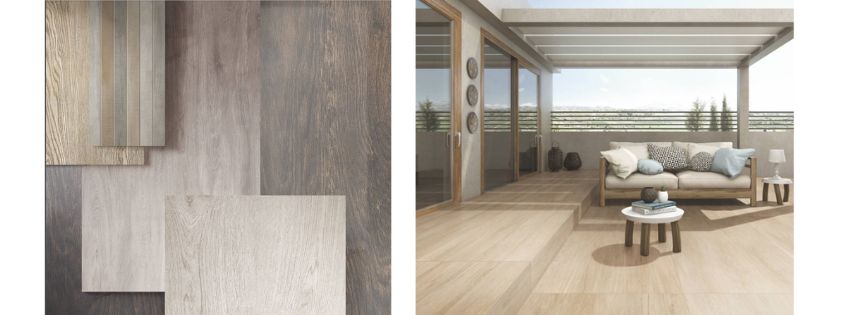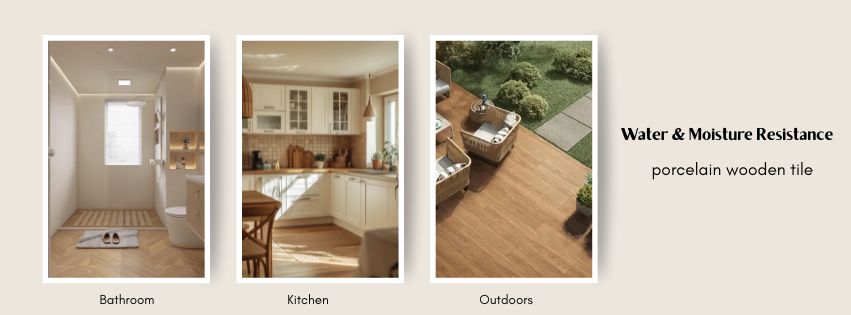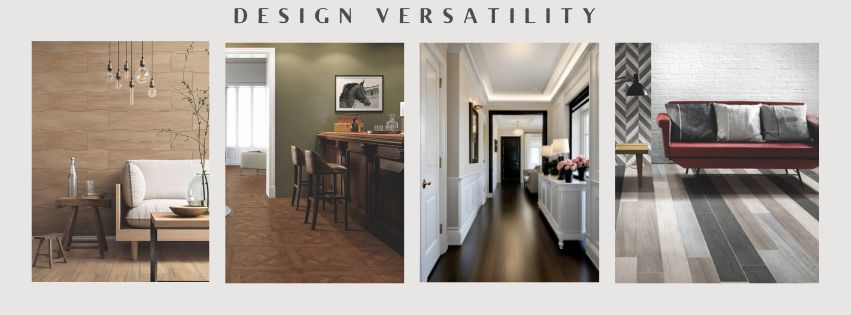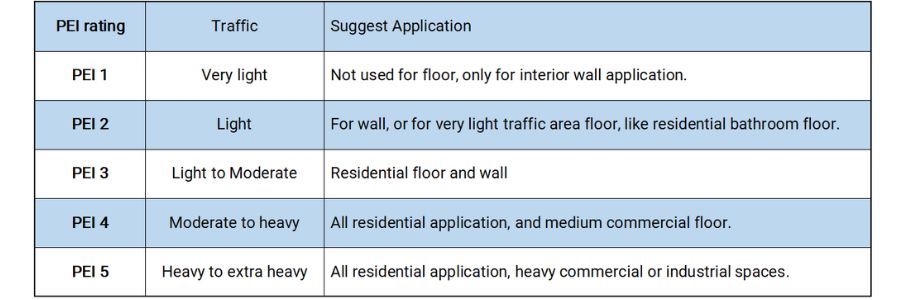Porcelain wood tiles aren’t perfect for every situation. As a supplier, I could easily focus only on the positives, but I believe my customers deserve the complete picture—both the advantages and the limitations.
In this post, I’ll share my insider perspective on the real pros and cons of porcelain wood tiles. I’ll explain what makes them special, where they excel, where they fall short, and how to determine if they’re the right choice for your next project. My goal is to give you honest, practical information that helps you make informed decisions when importing these products.
What Are Porcelain Wood Tiles?
Before diving into the pros and cons, let’s clarify exactly what we’re talking about. Porcelain wood tiles are ceramic tiles designed to mimic the appearance of natural wood. They’re made from refined clay that’s pressed and fired at extremely high temperatures, making them incredibly dense and durable.
The wood-like appearance comes from digital printing technology that creates realistic grain patterns on the surface. Many high-quality options also include texture that mimics the feel of real wood grain.
In today’s market, you’ll find several types:
- Standard porcelain wood tiles: The most common option, available in various sizes and finishes
- Large-format planks: Extra-long tiles that create fewer grout lines and a more authentic wood look
- Textured options: Tiles with embossed surfaces that feel similar to real wood grain
- Outdoor-rated wood tiles: Special versions designed to withstand outdoor conditions
Unlike actual hardwood, these tiles are made from clay and minerals rather than trees. Unlike vinyl or laminate wood-look options, they’re made from natural materials and are much more durable.


Major Benefits of Porcelain Wood Tiles (Pros)
Exceptional Durability
In my years as a supplier, durability is the number one reason buyers choose porcelain wood tiles over real wood. These tiles are incredibly tough!
Scratch resistance: While hardwood floors can be easily scratched by furniture, pet claws, or high heels, porcelain wood tiles resist scratching under most normal conditions.
Impact resistance: Quality porcelain wood tiles can withstand dropped objects better than many flooring alternatives. While no tile is totally immune to damage from heavy impacts, porcelain’s density makes it surprisingly strong.
Wear resistance: The color and pattern on good porcelain wood tiles go through the entire surface layer, meaning the design won’t wear away with heavy foot traffic. Many of my commercial clients install these in high-traffic areas specifically for this reason.
Water and Moisture Resistance
This is where porcelain wood tiles truly shine compared to real wood flooring.
Technical benefits: Porcelain tiles have extremely low porosity—typically less than 0.5% water absorption. This means they won’t warp, swell, or stain when exposed to water.
Practical applications: I’ve supplied porcelain wood tiles for bathrooms, kitchens, balcony, basements, and even indoor pools—all places where real wood would be problematic.
Climate advantages: For buildings in humid environments, porcelain wood tiles eliminate the expansion and contraction issues that plague real wood. We supply many projects in tropical and coastal regions specifically for this reason.


Low Maintenance Requirements
Another major advantage that my clients love is how easy porcelain wood tiles are to maintain.
Simple cleaning routine: Most dirt and spills can be handled with regular sweeping and occasional mopping with mild soap and water. No special cleaners required!
No refinishing needed: Unlike real wood floors that need sanding and refinishing every 5-7 years, porcelain wood tiles maintain their appearance indefinitely with proper care.
Stain resistance: The non-porous surface naturally resists stains from spills.
Design Versatility
The design options available with porcelain wood tiles have expanded dramatically in recent years.
Color range: Today’s manufacturing techniques can create everything from classic oak and walnut tones to whitewashed driftwood effects, gray-weathered finishes, and even unusual colors like blue or green “painted wood” looks.
Size variety: Standard sizes range from 6″x24″ to 8″x48″ and beyond. This variety allows for numerous pattern possibilities, from traditional layouts to creative designs like herringbone and chevron.
Finish options: You can choose from matte, semi-gloss, or textured finishes to achieve different looks and practical benefits. Textured finishes provide better slip resistance, while smoother finishes can be easier to clean.
Mix-and-match potential: Many of my clients combine different wood-look tiles or mix them with other tile types to create custom looks that would be difficult or impossible with real wood.


Cost Effectiveness
While the initial cost of quality porcelain wood tiles isn’t the lowest among flooring options, their long-term value is excellent.
Initial vs. lifetime cost: Quality porcelain wood tiles generally cost more upfront than laminate or vinyl options, but less than high-end hardwoods. However, their extreme longevity makes them more economical over time.
Installation considerations: Professional installation adds to the initial cost, but the lack of future refinishing expenses balances this out over the lifespan of the floor.
Return on investment: Many of my real estate developer clients choose porcelain wood tiles for their projects because they offer an upscale look that appeals to buyers while providing practical benefits that reduce future maintenance issues.
Environmental Benefits
For environmentally conscious clients, porcelain wood tiles offer several green advantages.
No deforestation: Because they don’t require harvesting trees, porcelain wood tiles don’t contribute to deforestation or habitat loss.
Product longevity: Their exceptional durability means fewer replacements and less material ending up in landfills over time.
Indoor air quality: Unlike some wood floors that may release VOCs (volatile organic compounds) from finishes and adhesives, properly installed porcelain tiles are inert and don’t affect indoor air quality.
Potential Drawbacks of Porcelain Wood Tiles (Cons)
As promised, I want to be completely honest about the potential drawbacks. Here’s what you should consider:
Feel Underfoot
The feel of porcelain wood tiles is noticeably different from real wood, and this is important to acknowledge.
Temperature difference: Porcelain tiles feel cooler underfoot than wood, which can be refreshing in hot climates but less comfortable in colder regions. I always recommend radiant floor heating systems to clients in cold climates who want porcelain wood tiles.
Hardness factor: The hardness of porcelain means less cushioning when walking. This can be tiring for people who stand for long periods. Strategic placement of area rugs in standing zones can help address this issue.
Sound effects: Porcelain floors can create more echo and sound reflection than wood. This is something to consider for spaces where acoustics matter, like recording studios or quiet living areas.
Installation and Initial Investment Challenges
Installation of porcelain wood tiles is more demanding than some other flooring options.
Subfloor requirements: The subfloor must be perfectly level and stable, as porcelain tiles have no flexibility to accommodate unevenness. Proper preparation often adds time and cost to installation.
Weight considerations: Porcelain tiles are heavy! This can be an issue for upper-floor installations where structural capacity might be limited. I always advise checking with a structural engineer before installing on upper floors.
Cutting complexity: Porcelain requires special tools for cutting, especially for the detailed cuts needed around doorways or other obstacles. This is definitely not a beginner-friendly DIY project.
Professional installation: While some flooring options are DIY-friendly, I strongly recommend professional installation for porcelain wood tiles. The complexity of creating perfectly level surfaces and proper alignment justifies the added expense.
Initial Investment: The upfront cost can be a hurdle for some projects. When factoring in materials, underlayment, installation labor, and finishing details like trim pieces, a porcelain wood tile floor represents a significant investment.
Repairs and Replacement
While porcelain wood tiles are extremely durable, repairs can be challenging when damage does occur.
Difficulty replacing single tiles: Removing and replacing individual damaged tiles can be difficult without disturbing surrounding tiles.
Batch variation concerns: Even with the same product code, tiles produced in different batches may have slight color variations. This makes it important to purchase extra tiles from your original order for potential future repairs.
Discontinued patterns: Manufacturers regularly update their collections, meaning exact replacements may not be available years later. I always advise clients to purchase 10-15% extra material for this reason.
Authenticity Factors
While today’s porcelain wood tiles look incredibly realistic, they don’t perfectly replicate all aspects of natural wood.
Pattern repetition: Even high-quality tiles will have some pattern repetition that doesn’t occur in natural wood. The best products minimize this with larger sets of unique patterns, but it’s still a limitation.
Texture limitations: While textured finishes mimic wood grain, they don’t perfectly capture the varied texture of real wood. Walking barefoot, most people can tell the difference.
Visual depth: Natural wood has a depth and warmth that’s difficult to fully replicate with porcelain, though the gap continues to narrow with advances in manufacturing technology.
Quality Variations in Porcelain Wood Tiles
Not all porcelain wood tiles are created equal. Understanding quality differences is crucial when importing these products.
Manufacturing Quality Tiers
In my experience, porcelain wood tiles generally fall into three quality tiers:
Budget tier: These tiles often have simpler patterns, less texture, and may have some technical limitations. They’re suitable for rental properties or short-term projects.
Standard tier: Good quality tiles with realistic patterns, decent texture, and solid technical specifications. These represent the best value for most residential and light commercial applications.
Premium tier: The most realistic appearance, advanced texturing, largest size options, and highest technical standards. These are ideal for luxury projects where appearance is paramount.
What Determines Porcelain Wood Tiles’ Quality
Several factors influence the quality and price of porcelain wood tiles:
Body composition: Better tiles use higher-grade clays and undergo more precise firing processes, resulting in stronger, more consistent products. By checking water absorption rates (should be under 0.5%), breaking strength (higher is better), and wear resistance ratings can know which one is good.
Printing technology: Advanced digital printing creates more detailed, realistic wood patterns. The best tiles use high-definition printing with numerous unique patterns to minimize repetition.
Surface treatments: Quality tiles feature specialized glazes and texturing processes that create authentic-looking wood grain you can actually feel.
Edge precision: Higher-quality tiles have precise, consistent dimensions and rectified edges (edges that have been precisely ground) for tighter, more professional-looking grout lines.
Best Applications for Porcelain Wood Tiles
Based on my experience working with clients worldwide, here’s where porcelain wood tiles perform best:


Ideal Indoor Spaces
Kitchens: The water and stain resistance make them perfect for cooking areas.
Bathrooms: Unlike real wood, they can handle constant moisture exposure with no issues.
Basements: Their moisture resistance prevents problems in below-grade installations.
Open-concept homes: They create visual continuity across various functional areas.
High-traffic areas: Entryways, hallways, and living rooms benefit from their durability.
Outdoor Possibilities
With proper outdoor-rated products:
Covered patios: Create a seamless indoor-outdoor transition.
Pool decks: Provide the look of wood without the maintenance or slip hazards.
Rooftop terraces: Offer the warmth of wood with the durability needed for exposed locations.
Commercial Applications
Many of my commercial clients choose porcelain wood tiles for:
Retail spaces: They withstand heavy foot traffic while providing an inviting atmosphere.
Restaurants: They resist stains and are easy to clean while offering warmth and style.
Hotels: Public areas and guest rooms benefit from their durability and luxurious appearance.
Offices: They create a welcoming environment that stands up to daily use.
Challenging Environments
Porcelain wood tiles excel in situations that would damage real wood:
Wet areas: Shower floors, sauna surroundings, indoor pool decks.
Sunny spaces: Unlike wood, they won’t fade from UV exposure in sunrooms or south-facing rooms.
Coastal locations: They resist the humidity and salt air that can damage wood floors.
Radiant heating systems: They conduct heat efficiently without the expansion issues of real wood.
Tips for Choosing the Right Porcelain Wood Tiles
After helping countless clients select the perfect tiles for their projects, here’s my advice:
Understanding Tile Grading and Classification
Look for these classifications on product specifications:
PEI rating: This measures wear resistance on a scale of 1-5. For floors, choose at least PEI 3 for residential and PEI 4-5 for commercial applications.


Frost resistance: If using outdoors in areas that freeze, ensure tiles are rated “frost resistant.”
Key Technical Specifications to Check
When reviewing product datasheets, pay attention to:
Water absorption rate: Should be less than 0.5% for true porcelain.
Breaking strength: Higher values indicate more durable tiles.
Shade variation rating: V1 (uniform) to V4 (substantial variation). Most wood-look tiles should be V3 or V4 for natural appearance.
Rectified edges: These allow for tighter grout lines and more precise installation.
Evaluating Pattern Variation
For the most natural look:
Number of faces: Ask how many different pattern variations exist in each batch. More is better—quality products often have 20+ unique faces.
Random placement: Look at a larger installed area (or ask for photos) to ensure patterns don’t noticeably repeat in adjacent tiles.
Veining and knots: Natural-looking variations, including occasional knots and color shifts, create a more authentic appearance.
Sample Assessment Techniques
Before making large orders:
Order multiple samples: Examine several tiles to check for pattern repetition.
View in your space: Look at samples in the actual installation location with your lighting conditions.
Water test: Place a drop of water on the back of the tile. The longer it takes to absorb, the more dense and durable the tile.
What You Need to Ask Your Supplier
As a supplier myself, here are questions I’m happy to answer for serious buyers:
Technical data sheets: Should provide all relevant specifications and testing results.
Packaging: Most wooden tiles are look plank look and it’s easy to get broken if the carton protection is not good enough.
Minimum order quantities: Important for commercial projects or future repairs.
Shipping and lead times: Realistic timeframes for planning your project.
Red Flags to Watch For
Be cautious if you encounter:
Inconsistent sizing: Variation between samples indicates poor quality control.
Pricing that seems too good to be true: Exceptionally low prices often indicate cut corners in materials or manufacturing.
Limited pattern variation: Fewer than 6 unique patterns typically results in obvious repetition.
Reluctance to provide samples: Reputable suppliers are happy to send samples of their products.
Frequently Asked Questions
1. Will porcelain wood tiles increase my property value?
In most cases, yes. Quality tile flooring is generally viewed positively by real estate professionals, especially in kitchens, bathrooms, and main living areas. The combination of an upscale wood look with practical benefits appeals to many buyers.
2. Will porcelain wood tiles go out of style?
Wood-look finishes have remained popular for decades. While specific colors and patterns may trend in and out, the general appeal of wood-look flooring has proven remarkably stable over time. Choosing moderate, natural tones rather than extreme colors provides the best long-term style potential.
3. Can porcelain wood tiles be installed over existing floors?
Often, yes. They can be installed over existing tile, concrete, or other stable surfaces as long as the surface is completely level. However, this typically adds height to the floor, which may create transition issues at doorways or with existing fixtures.
4. Are porcelain wood tiles suitable for radiant heating?
Absolutely! They’re one of the best flooring choices for radiant heating systems, as they conduct and retain heat efficiently. Their stability means they won’t expand and contract with temperature changes like real wood.
5. How do they perform in commercial settings?
Exceptionally well. Commercial-rated porcelain wood tiles are designed to withstand heavy traffic, resist staining, and maintain their appearance with minimal maintenance. Many of my commercial clients report excellent performance even after years of heavy use.
Conclusion
After supplying porcelain wood tiles to projects worldwide for over 15 years, I’ve developed a deep appreciation for both their impressive strengths and their few limitations.
For most applications, the advantages of porcelain wood tiles—durability, water resistance, low maintenance, design flexibility, and long-term value—far outweigh their drawbacks. When quality products are properly installed, they provide years of trouble-free performance while maintaining their beautiful appearance.
I hope this insider perspective helps you make informed decisions for your next flooring project. If you have specific questions about porcelain wood tiles for your unique application, don’t hesitate to reach out. As a supplier, nothing makes me happier than helping clients find the perfect solution for their needs.
Looking for high-quality porcelain wood tiles for your next project? Visit www.tilesandbathroom.com to know more about us or contact us directly today!
Related Post:
Creative Wood Tile Patterns That Will Make Your Floors Stand Out
Ceramic vs Porcelain Tile, Tile Comparison Guides
Tile vs Wood Flooring: Pros, Cons, and Market Opportunities for Importers



